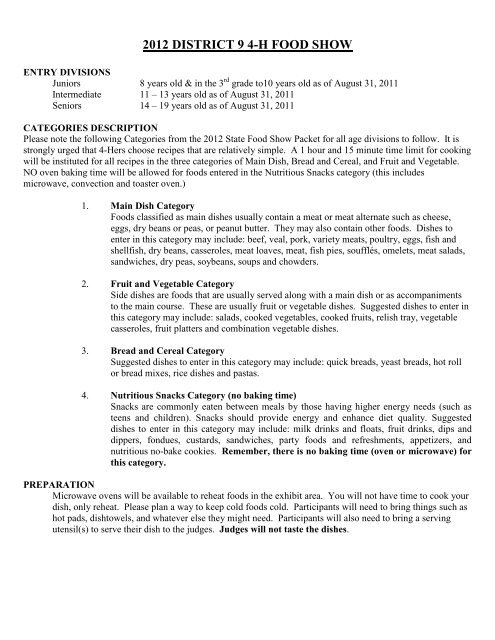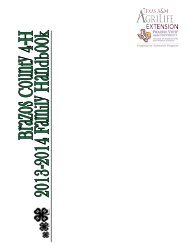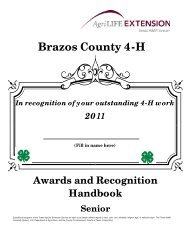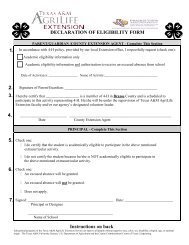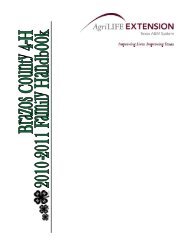2012 District 9 4-H Food Show Record Form Guidelines - Brazos
2012 District 9 4-H Food Show Record Form Guidelines - Brazos
2012 District 9 4-H Food Show Record Form Guidelines - Brazos
Create successful ePaper yourself
Turn your PDF publications into a flip-book with our unique Google optimized e-Paper software.
<strong>2012</strong> DISTRICT 9 4-H FOOD SHOWENTRY DIVISIONSJuniors 8 years old & in the 3 rd grade to10 years old as of August 31, 2011Intermediate 11 – 13 years old as of August 31, 2011Seniors 14 – 19 years old as of August 31, 2011CATEGORIES DESCRIPTIONPlease note the following Categories from the <strong>2012</strong> State <strong>Food</strong> <strong>Show</strong> Packet for all age divisions to follow. It isstrongly urged that 4-Hers choose recipes that are relatively simple. A 1 hour and 15 minute time limit for cookingwill be instituted for all recipes in the three categories of Main Dish, Bread and Cereal, and Fruit and Vegetable.NO oven baking time will be allowed for foods entered in the Nutritious Snacks category (this includesmicrowave, convection and toaster oven.)1. Main Dish Category<strong>Food</strong>s classified as main dishes usually contain a meat or meat alternate such as cheese,eggs, dry beans or peas, or peanut butter. They may also contain other foods. Dishes toenter in this category may include: beef, veal, pork, variety meats, poultry, eggs, fish andshellfish, dry beans, casseroles, meat loaves, meat, fish pies, soufflés, omelets, meat salads,sandwiches, dry peas, soybeans, soups and chowders.2. Fruit and Vegetable CategorySide dishes are foods that are usually served along with a main dish or as accompanimentsto the main course. These are usually fruit or vegetable dishes. Suggested dishes to enter inthis category may include: salads, cooked vegetables, cooked fruits, relish tray, vegetablecasseroles, fruit platters and combination vegetable dishes.3. Bread and Cereal CategorySuggested dishes to enter in this category may include: quick breads, yeast breads, hot rollor bread mixes, rice dishes and pastas.4. Nutritious Snacks Category (no baking time)Snacks are commonly eaten between meals by those having higher energy needs (such asteens and children). Snacks should provide energy and enhance diet quality. Suggesteddishes to enter in this category may include: milk drinks and floats, fruit drinks, dips anddippers, fondues, custards, sandwiches, party foods and refreshments, appetizers, andnutritious no-bake cookies. Remember, there is no baking time (oven or microwave) forthis category.PREPARATIONMicrowave ovens will be available to reheat foods in the exhibit area. You will not have time to cook yourdish, only reheat. Please plan a way to keep cold foods cold. Participants will need to bring things such ashot pads, dishtowels, and whatever else they might need. Participants will also need to bring a servingutensil(s) to serve their dish to the judges. Judges will not taste the dishes.
FORMS REQUIRED FOR <strong>2012</strong> DISTRICT 9 4-H FOOD SHOW** 0.5 point per judge will be deducted for incomplete or incorrect paper work.1. <strong>2012</strong> <strong>District</strong> 9 4-H <strong>Food</strong> <strong>Show</strong> <strong>Record</strong> <strong>Form</strong>. Send the original copy of the form, along with twocopies, available in this guide. Hard copies of the form will be returned to the contestant, however, it isrecommended that a photocopy be made and retained by the contestant. The record should cover one year’s4-H work for <strong>Food</strong> <strong>Show</strong> to next year’s <strong>Food</strong> <strong>Show</strong>.2. <strong>Food</strong> & Nutrition Project Adventures Page. This is where you will share your <strong>Food</strong> and Nutrition projectstory. Be sure to include your food & nutrition project related goals, project activities, knowledge & skills,leadership, and community service. Please limit your story to food and nutrition project experiences. (1 pagelimit, do not attach pages. No smaller than 10 pt. font)3. Recipe. Recipe should be written according to the example of standard Recipe Written in Standard <strong>Form</strong>.(Also see example of recipe written in correct form along with Check Sheet.)4. <strong>2012</strong> <strong>District</strong> 9 4-H <strong>Food</strong> <strong>Show</strong> Scorecard. Send original, along with two copies.5. Entry and payment should be made through 4-H Connect by April 15, <strong>2012</strong>.6. Submit all entry forms to your County Extension Agent by Monday, April 9, <strong>2012</strong>. Agent mustsubmit all County <strong>Food</strong> <strong>Show</strong> <strong>Form</strong>s and Scorecards (3 copies of each per participant) to the <strong>District</strong>Office no later than Monday, April 16, <strong>2012</strong>.NOTE: Double check to make sure that agent, 4-H’er, and parent/guardian, have signed the first page of theform and that the recipe adheres to the Check Sheet for Recipe Written in Standard <strong>Form</strong>.
CHECK SHEET FOR RECIPE WRITTEN IN STANDARD FORM(Also see example recipe following.)I. Does Your Recipe Have All of These Parts? Yes Noa. Name of Recipeb. Complete list of ingredientsSize cans, packages, cans, etc. givenEX: 10 oz. box chopped frozen spinach NOT Spinach, box of spinach or frozen spinach.c. Description for combining all ingredientsII. List of Ingredientsa. Ingredients are listed in order in which they are usedb. Ingredients listed as they are measured, i.e. the word describing is in the correct place.EX: 1/4 cup chopped onion, not ¼ cup onion chopped.EX: 1 green pepper, chopped, not 1 chopped green pepperc. Measurements given in common fractionsi.e. 1/4 cup, 2 tablespoons, 1 teaspoond. All measurements are spelled out, not abbreviated.EX: cup, teaspoon, tablespoon, size can, etc. (i.e. 4-ounce can)e. Avoid brand names. Include complete description of ingredients,i.e. low-fat, packed in syrup, reduced fat, etc.III. DirectionsI have. . . . . . .a. Used clear instructions for every step of combining and cooking the ingredientsb. Used short, clear sentencesc. Used the correct word to describe combining and cooking processesd. Stated the size of pane. Given the temperature and cooking timef. Included the number of servings or how much the recipe would make
6-ounce package lime gelatin2 cups boiling water1 cup lemon-lime soda8-ounce package low-fat cream cheese, softenedExample of Recipe4-H Shamrock Salad(not just 1 package lime gelatin)(not just 1 package/ what kind?Low fat, Fat free, etc.)½ teaspoon vanilla11-ounce can mandarin oranges, drained(always include size)8-ounce can pineapple tidbits, drained2 cups red grapes, halved, seeded (not just grapes, also color/kind?Red, concord, green)2 cups chopped celery (not 2 cups celery chopped - you must chopthe celery to measure it, so chopped must bewritten first)½ cup chopped pecans8-ounce carton frozen low-fat whipped topping, thawed3-ounce package lime gelatin1 ½ cups boiling water(are you measuring the pecans before orafter chopping? The way it is written hereindicates chopping first)(indicate low-fat, fat-free, etc.)Dissolve the 6-ounce package lime gelatin in 2 cups boiling water. Stir in 1 cup lemon-lime soda. Combine thiswith cream cheese and vanilla in blender, and process until smooth. Pour blended mixture into bowl. Stir in allfruit, celery and pecans. Fold in three-fourths carton whipped topping. Pour into 13x9x2-inch pan. (Note size ofpan is listed) Chill until firm; then cut whole pan into 8 equal-sized portions.To make the 4-H Shamrock gelatin jigglers, dissolve the 3-ounce package lime gelatin in the 1 ½ cups boilingwater. Pour into shallow pan, 24x16x1 inches. Chill until set. Cookie cut the jiggler gelatin into 4-H Shamrockshapes. Serve salad squares on lettuce-lined plate. Top with 4-H Shamrocks. Garnish with remaining whippedtopping. Chill until serving time. May add other garnishes to serving tray for color variety. Yield: 8 servings.(Note number of servings is listed)
<strong>2012</strong> <strong>District</strong> 9 4-H <strong>Food</strong> <strong>Show</strong> <strong>Record</strong> <strong>Form</strong> <strong>Guidelines</strong>The following guidelines are designed to help 4-H’ers better understand and utilize the <strong>District</strong> 9 4-H <strong>Food</strong> <strong>Show</strong><strong>Record</strong> <strong>Form</strong>. Please read and consider each one carefully as 0.5 points will be deducted from total score forincorrect submissions.1. Type size and font must be legible and easily read. Minimum Font Size - 10.2. No additional lines or pages may be added. Except where stated on the recipe (Attach separate sheet ifnecessary)3. No written menu is required.4. The project form is worth 30% of your overall score. This includes <strong>Food</strong> and Nutrition Project AdventuresPage and recipe.5. Do not leave any blanks. This information is necessary for participation.6. Age of a <strong>2012</strong> <strong>Food</strong> <strong>Show</strong> participant is determined by age as of August 31, 2011.7. For "years in 4-H" and "years in project", include the current year. Do not include clover kid’s involvement.8. <strong>Food</strong> and Nutrition Project Adventures Page● Goals are worth 5 points of your total score. Goals are things that you had hoped to learn or accomplish atthe beginning of the project year. A goal may also be ongoing for one or more years. There is no setnumber of goals required.● Leadership is worth 5 points of your total score. Your volunteer, elected/appointed, and promotionalleadership experiences in <strong>Food</strong>s & Nutrition in the current project year.● Community Service is worth 5 points of your total score. Your community service experience in <strong>Food</strong>sand Nutrition for the current project year.● Knowledge and Skills Learned is worth 5 points of your total score. Summarize what you have learned in<strong>Food</strong>s & Nutrition in the current project year.● Project Activities is worth 5 points of your total score. Your <strong>Food</strong>s and Nutrition activities for the currentproject year, such as contests, workshops, project meetings, etc.9. Recipe is worth 5 points of your total score. Include the complete recipe for your dish, including anysubstitutions or variations, as well as preparation procedures and the number of servings. Please refer to thesample recipe and check sheet for detailed instructions on how to submit recipes.10. Sign and date your form. This is a contract and your signature certifies that the information shown is true,and completed in the current project year.
Interview and Contestant <strong>Guidelines</strong>, Judging andScoring the <strong>District</strong> 9 4-H <strong>Food</strong> <strong>Show</strong>The Project <strong>Record</strong> <strong>Form</strong>, which is a one-page project summary and includes the entry recipe, is required. AMenu Analysis is not required for the <strong>District</strong> 9 4-H <strong>Food</strong> <strong>Show</strong>.A detailed explanation of the <strong>2012</strong> <strong>District</strong> 9 4-H <strong>Food</strong> <strong>Show</strong> Scorecard and what contestants can expect during theinterview follows.<strong>2012</strong> <strong>District</strong> 9 4-H <strong>Food</strong> <strong>Show</strong> ScorecardJunior Intermediate SeniorCircle one aboveCategory: ____ Main Dish _____ Fruit and Vegetable____ Bread and Cereal _____ Nutritious SnacksParticipant Name: _____________________________________________ County: _______________________The upper section of the card is for information. Use the name to identify the contestant. Each participant will bea 4-H’er between the ages of 8 and in the 3 rd grade and 19; however, some may have many more years ofexperience in the <strong>Food</strong> and Nutrition Project than others. Less experienced 4-H’ers should not be expected toachieve the same skill levels as more experienced ones.The category information on the scorecard prepares you to look for and listen to certain things that are appropriatefor that category. For example, if the category is main dish, then you know the dish prepared may contain meat ormeat alternatives such as cheese, eggs, dry beans or peas or peanut butter. It may be a casserole, soup, salad, etc.The four categories are as follows: Main Dish, Fruit and Vegetable, Bread and Cereal and Nutritious Snacks.1. FORMThis section evaluates information on the participants’ <strong>District</strong> 9 4-H <strong>Food</strong> <strong>Show</strong> <strong>Record</strong> <strong>Form</strong>. The explanation ofeach item scored follows. Judging of the form will take place prior to the <strong>District</strong> 9 4-H <strong>Food</strong> <strong>Show</strong>.Comments Category Poor Fair Avg Good Exc1. <strong>Form</strong>a. Goals 1 2 3 4 5b. Project activities 1 2 3 4 5c. Knowledge & skills 1 2 3 4 5d. Leadership 1 2 3 4 5e. Community Service 1 2 3 4 5
A. Goals. This section explains how and/or why goals were selected and what implications this has for thefuture.B. Project activities. Includes the six learning experiences that explain how the knowledge and skills weregained. It might include demonstrations, tours, internet, project meetings, exhibits, experiments,workshops, self-study, research, reading, etc.C. Knowledge and skills. Specific skills or items learned by the contestant during this project. The writtenrecipe evaluation will be counted in this category.D. Leadership. Leadership means taking the lead in giving direction, planning and organizing. Effectiveleadership depends on help and assistance from others, but helping is a supportive role, not leadership.Examples include conducting a meeting or giving a demonstration or talk.E. Community Service. This is what the participant as an individual or with a group performs to help thecommunity. Community service is for an audience that is not 4-H and that is not the family of thecontestant.2. RECIPEThe recipe category will account for the contestant’s ability to correctly write a recipe in the format given in thisguide.Comments Category Poor Fair Avg Good Exc2. Recipe 1 2 3 4 53. COMMUNICATION SKILLSCommunicating is ability to exchange information effectively and will score voice, poise and presentationorganization in Section 3.Comments Category Poor Fair Avg Good Exc3. Communication Skillsa. Voice 1 2 3 4 5b. Poise 1 2 3 4 5c. Presentation 1 2 3 4 5A. Voice. Vocal diction, inflection, tone and expressions of participants. Contestant speaks clearly and in the tonethat can be heard and understood.B. Poise. Eye contact, posture, gestures and self-confidence of participants. Participant makes good eye contact,has good posture and no distracting mannerisms.C. Presentation organization. Methodical, organized way of presenting and information in the three-minutepresentation and in organizing answers to the questions. Presentation should show planning and follow a logicalorder.
4. INTERVIEWALL PARTICIPANTS:Participants will be judged on an individual basis. Judges will not taste the food.Each 4-H member should enter the judging area with serving utensil(s), a napkin to place their serving utensil onprior to serving, and their food in containers appropriate and necessary to present and serve the dish to be judged.Disposable gloves are not needed if a serving utensil is utilized. Fancy or elaborate placemats, linens,centerpieces, candles, serving trays, etc., are not to be included with the dish as it is presented for judging andinterviews. The 4-Her may stand or sit behind the display while the judges sit facing the participant across thetable. Only edible garnishes are allowed on your dish.Contestants are encouraged to practice proper food handling techniques when presenting food to the judges.After the participant has served the judges, the judges will thank them and the 4-Her will return their dish to thedisplay area.JUNIORS and INTERMEDIATES:Juniors and Intermediates will have a 5-minute timed interview with the judges. During that time the judges willask the participants questions. Participants should review the scorecard and be prepared to answer questions abouttheir dish and their <strong>Food</strong> and Nutrition Project experiences according to the scoring sections on the scorecard.Juniors and Intermediates may have a copy of their recipe to use as a reference.Toward the end of the 5-minute session the judges will ask the participant to serve a small portion of their dish.SENIORS:Seniors will have a timed 11-minute presentation and interview session. The seniors should start with a 3-minutepresentation which will be followed by an 8-minute session of questions from the panel of judges.Participants should prepare a three minute oral presentation. It will be an oral presentation with no handouts orvisuals. In this time, they may introduce themselves and their dish, and may describe briefly their inspiration inchoosing that dish, or their experience in 4-H and the <strong>Food</strong> and Nutrition Project or information on anycombination for the following topics.-Project activities from current year’s project- Special learning experiences from current year’s project- Leadership activities from current year’s project- Career options explored in current year’s project- Dietary lifestyle choices explored in current year’s project examples:*new foods experienced*special diet information*special food needs*why the entry dish was selected?*category selection – why did you choose to submit your recipe in this category?Remember, this is the participants’ opportunity to stand out, market oneself, and be creative!The judging team will have 8 minutes following the participant presentation to address topics listed below as wellas topics listed above that were not addressed by the participant. During the judges’ questioning session, theparticipant should only answer the question asked by the judges.Toward the end of the 11-minute session the judges will ask the participant to serve a small portion of their dish.
This section evaluates information on the participants’ <strong>District</strong> 9 4-H <strong>Food</strong> <strong>Show</strong> <strong>Record</strong> <strong>Form</strong>. The explanation ofeach item scored follows.Comments Category Poor Fair Avg Good Exc4. Interviewa. Experiences 1 2 3 4 5b. Knowledge gained 1 2 3 4 5c. Preparation principles 1 2 3 4 5d. Ingredient function 1 2 3 4 5e. Nutrients & functions 1 2 3 4 5f. Dietary guidelines 1 2 3 4 5g. Calorie Content 1 2 3 4 5h. <strong>Food</strong> safety 1 2 3 4 5i. Diet & lifestyle 1 2 3 4 5A. Experiences. Project activities, special learning experiences/opportunities, leadership activities, and careerexploration–this is the how and why of project.B. Knowledge Gained. How were the skills and knowledge acquired used and how will they affect the future.C. Preparation principles. Explanation of the critical steps and utensils used in food preparation. (i.e. cookingitems, proper measurements, correct method of cooking a particular food)D. Ingredient function. Importance of ingredients and their effects on the outcome of a recipe, modifications thatcan be made in recipe and the outcomes.E. Nutrients and functions. Key nutrients (vitamins, minerals, protein, carbohydrates, fat, fiber) in a recipe andtheir function in the diet.F. Dietary <strong>Guidelines</strong>. Basic concepts related to Dietary <strong>Guidelines</strong> and the MyPyramid.G. Calorie Content. The calorie needs and calorie contribution of common foods. Basic concepts related to thePhysical Activity <strong>Guidelines</strong> for Americans.H. <strong>Food</strong> Safety. Concerns during the purchase, preparation, serving and storage of a recipe. Basic concepts relatedto FightBac.I. Diet and lifestyle. New food experiences, special food needs, special diet information and why the entry dishwas selected. 4-H participants should be able to describe a meal menu containing their entry.5. FOODThis section focuses on the food that is being exhibited by participant. After the interview, the participant willremove the display from the judging area.This following explains the items scored in Section 5.Comments Category Poor Fair Avg Good Exc5. <strong>Food</strong>
a. Appearance/appeal 1 2 3 4 5b. Quality 1 2 3 4 5PENALTY POINTS of ½ point per judge will be deducted from total score for incorrect submissions.Please review the <strong>2012</strong> <strong>District</strong> 9 4-H <strong>Food</strong> <strong>Show</strong> <strong>Record</strong> <strong>Form</strong> <strong>Guidelines</strong>6. COMMENTSIn the left section of the scorecard is the place for constructive comments. Judges’ scores are removed after thescores are tabulated but the comments are sent to the contestants to help them learn as much as possible from their<strong>Food</strong> <strong>Show</strong> experience.<strong>2012</strong> <strong>Food</strong> <strong>Show</strong> Study Guides:You are encouraged to be familiar with basic cooking principles and the use of cooking utensils. This informationcan be found in Cooking Basics for Dummies, 3rd editionOther resources include:MyPlatehttp://www.choosemyplate.gov/Dietary <strong>Guidelines</strong> for Americans, 2010http://www.health.gov/dietaryguidelines/dga2010/Dietary<strong>Guidelines</strong>2010.pdfFight Bac! Fight <strong>Food</strong>borne Bacteriahttp://www.fightbac.org/storage/documents/flyers/fightbac_color_brochure.pdf


